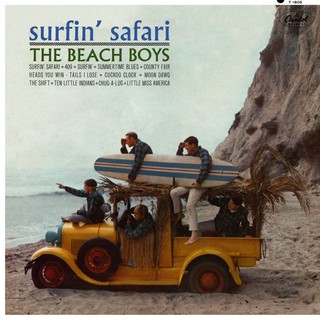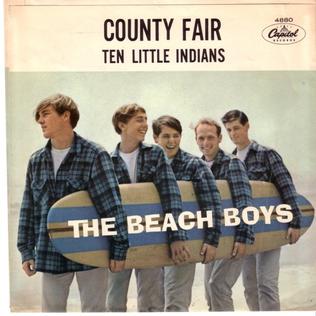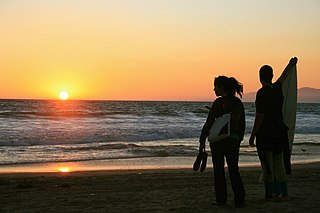
The Beach Boys are an American rock band formed in Hawthorne, California, in 1961. The group's original lineup consisted of brothers Brian, Dennis, and Carl Wilson, their cousin Mike Love, and friend Al Jardine. Distinguished by their vocal harmonies, adolescent-oriented lyrics, and musical ingenuity, they are one of the most influential acts of the rock era. They drew on the music of older pop vocal groups, 1950s rock and roll, and black R&B to create their unique sound. Under Brian's direction, they often incorporated classical or jazz elements and unconventional recording techniques in innovative ways.

Jan and Dean were an American rock duo consisting of William Jan Berry and Dean Ormsby Torrence. In the early 1960s, they were pioneers of the California Sound and vocal surf music styles popularized by the Beach Boys.
Surf music is a genre of rock music associated with surf culture, particularly as found in Southern California. It was especially popular from 1958 to 1964 in two major forms. The first is instrumental surf, distinguished by reverb-heavy electric guitars played to evoke the sound of crashing waves, largely pioneered by Dick Dale and the Del-Tones. The second is vocal surf, which took elements of the original surf sound and added vocal harmonies, a movement led by the Beach Boys.

David Lee Marks is an American guitarist who was an early member of the Beach Boys. While growing up in Hawthorne, California, Marks was a neighborhood friend of the original band members and was a frequent participant at their family get-togethers. Following his departure from the group, Marks fronted the Marksmen and performed and recorded as a session musician.

Carl Dean Wilson was an American musician who co-founded the Beach Boys. He was their lead guitarist, the youngest sibling of bandmates Brian and Dennis, and the group's de facto leader in the early to mid-1970s. He was also the band's musical director on stage from 1965 until his death.

Surfin' Safari is the debut studio album by the American rock band the Beach Boys, released October 1, 1962 on Capitol Records. The official production credit went to Nick Venet, though it was Brian Wilson with his father Murry who contributed substantially to the album's production; Brian also wrote or co-wrote nine of its 12 tracks. The album reached number 32 in the US during a chart stay of 37 weeks.

Surfin' U.S.A. is the second studio album by the American rock band the Beach Boys, released March 25, 1963 on Capitol Records. It reached number 2 in the US during a chart stay of 78 weeks, eventually being certified gold by the RIAA, and brought the group newfound national success. It was led by one single, its title track with the B-side "Shut Down". In the UK, the album was released in late 1965 and reached number 17.

Surfer Girl is the third studio album by the American rock band the Beach Boys, released September 16, 1963 on Capitol Records. It is largely a collection of surf songs. The LP reached number 7 in the U.S. and number 13 in the UK. Lead single "Surfer Girl", backed with "Little Deuce Coupe", was also a top 10 hit.

All Summer Long is the sixth album by American rock band the Beach Boys, released July 13, 1964 on Capitol Records. Regarded as their first artistically unified collection of songs, as well as one of the first true concept albums, it marked the Beach Boys' first LP that was not focused on themes of cars or surfing. Instead, the songs are semi-autobiographical and relate to the experiences of a typical Southern Californian teenager, a theme encapsulated by the title track, "All Summer Long", and the often-imitated front cover, a modernist style photo collage depicting the band members fraternizing with young women on a beach.

The Honeys were an American girl group, formed in Los Angeles in 1958, that initially comprised sisters Marilyn, Diane, and Barbara Rovell. Barbara was later replaced by their cousin, Ginger Blake. After 1962, the Rovell Sisters were rechristened "the Honeys" by the Beach Boys' Brian Wilson, who envisioned the group as a female counterpart to his band. Wilson served as the Honeys' record producer and chief songwriter, and later married Marilyn in late 1964.

"Surfin' Safari" is a song by American rock band the Beach Boys, written by Brian Wilson and Mike Love. Released as a single with "409" in June 1962, it peaked at number 14 on the Billboard Hot 100. The song also appeared on the 1962 album of the same name.

"Surfin'" is a song by American rock band the Beach Boys that was written by Brian Wilson and Mike Love. It was released as the debut record by the Beach Boys in November 1961 on Candix Records and was included on the October 1962 album Surfin' Safari.

"County Fair" is a song written by Brian Wilson and Gary Usher for the American rock band The Beach Boys. It was originally released as the second track on their 1962 album Surfin' Safari. On November 26 of that year, it was released as the B-side to The Beach Boys' third single, "Ten Little Indians". The same single was released in the UK in January 1963.

"Dead Man's Curve" is a 1964 hit song by Jan and Dean whose lyrics detail a teen street race gone awry. It reached number eight on the Billboard Hot 100 singles chart and number 39 in Canada. The song was written and composed by Brian Wilson, Artie Kornfeld, Roger Christian, and Jan Berry at Wilson's mother's house in Santa Monica. It was part of the teenage tragedy song phenomenon of that period, and one of the most popular such selections of all time. "Dead Man's Curve" was added to the Grammy Hall of Fame in 2008.

"Sidewalk Surfin'" is a song with music by Brian Wilson and lyrics by Roger Christian, which was recorded by 1960s American pop singers Jan and Dean. The song was recorded as a single and then appeared on the 1964 album Ride the Wild Surf, and later on the Little Old Lady from Pasadena album. The B-side of the single is "When It's Over." "Sidewalk Surfin'" reached number 25 on the Billboard Hot 100 on October 31, 1964, which was Jan and Dean's lowest-charting single in a year and a half since the release of their number one hit single "Surf City." Jan and Dean were known for their music of the 1960s surf era with songs like "Dead Man's Curve," "Drag City," and "The Little Old Lady from Pasadena."

The California sound is a popular music aesthetic that originates with American pop and rock recording artists from Southern California in the early 1960s. At first, it was conflated with the California myth, an idyllic setting inspired by the state's beach culture that commonly appeared in the lyrics of commercial pop songs. Later, the sound was expanded outside its initial geography and subject matter and was developed to be more sophisticated, often featuring studio experimentation.
"The New Girl in School" is a song written by Jan Berry, Roger Christian, Brian Wilson, and Bob Norberg for the American rock duet Jan and Dean. It was the B-side of their hit single "Dead Man's Curve". Both songs were released on their album Dead Man's Curve / The New Girl In School. "The New Girl From School" charted at number 37 on the Billboard Hot 100. In Canada the song was co-charted with "Dead Man's Curve" and they reached number 39.
This is the discography for American rock duo Jan and Dean.

"Surfin' U.S.A." is a song by the American rock band the Beach Boys, credited to Chuck Berry and Brian Wilson. It is a rewritten version of Berry's "Sweet Little Sixteen" set to new lyrics written by Wilson and an uncredited Mike Love. The song was released as a single on March 4, 1963, backed with "Shut Down". It was then placed as the opening track on their album of the same name.
"Farmer's Daughter" is a song by the American rock band the Beach Boys, appearing on their Surfin’ U.S.A. album in 1963. Although the song was originally solely credited to Brian Wilson, Mike Love was later awarded a writing credit. "Farmer's Daughter" was later covered by Fleetwood Mac on their 1980 Live album and released as a single in Austria, where it reached the top ten.















